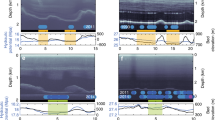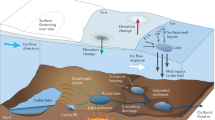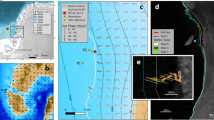Abstract
The subglacial Lake Vostok may be a unique reservoir of genetic material and it may contain organisms with distinct adaptations1,2,3, but it has yet to be explored directly. The lake and the overlying ice sheet are closely linked, as the ice-sheet thickness drives the lake circulation, while melting and freezing at the ice-sheet base will control the flux of water, biota and sediment through the lake4,5,6,7. Here we present a reconstruction of the ice flow trajectories for the Vostok core site, using ice-penetrating radar data and Global Positioning System (GPS) measurements of surface ice velocity. We find that the ice sheet has a significant along-lake flow component, persistent since the Last Glacial Maximum. The rates at which ice is frozen (accreted) to the base of the ice sheet are greatest at the shorelines, and the accreted ice layer is subsequently transported out of the lake. Using these new flow field and velocity measurements, we estimate the time for ice to traverse Lake Vostok to be 16,000–20,000 years. We infer that most Vostok ice analysed to date was accreted to the ice sheet close to the western shoreline, and is therefore not representative of open lake conditions. From the amount of accreted lake water we estimate to be exported along the southern shoreline, the lake water residence time is about 13,300 years.
This is a preview of subscription content, access via your institution
Access options
Subscribe to this journal
Receive 51 print issues and online access
$199.00 per year
only $3.90 per issue
Buy this article
- Purchase on Springer Link
- Instant access to full article PDF
Prices may be subject to local taxes which are calculated during checkout




Similar content being viewed by others
References
Kapitsa, A. P., Ridley, J. K., Robin, G. de Q., Siegert, M. J. & Zotikov, I. A. A large freshwater lake beneath the ice of central East Antarctica. Nature 381, 684–686 (1996).
Karl, D. M. et al. Microorganisms in the accreted ice of Lake Vostok, Antarctica. Science 286, 2144–2147 (1999).
Priscu, J. C. et al. Geomicrobiology of subglacial ice above Lake Vostok, Antarctica. Science 286, 2141–2144 (1999).
Siegert, M. J., Kwok, K., Mayer, C. & Hubbard, B. Water exchange between the subglacial Lake Vostok and the overlying ice sheet. Nature 403, 643–646 (2000).
Jouzel, J. et al. More than 200 meters of lake ice above subglacial Lake Vostok, Antarctica. Science 286, 2138–2141 (1999).
Jean-Baptiste, P., Petit, J.-R., Lipenkov, V. Y., Raynaud, D. & Barkov, N. I. Constraints on hydrothermal processes and water exchange in Lake Vostok from helium isotopes. Nature 411, 460–462 (2001).
Siegert, M. J. et al. Physical, chemical and biological processes in Lake Vostok and other Antarctic subglacial lakes. Nature 414, 603–609 (2001).
Popov, S. V., Mironov, A. V. & Sheremetiev, A. N. Average of the electromagnetic wave propagation velocity in ice measurements in Vostok station vicinity. Materialy Glyatsiologicheskikh Issledovanii (Data of Glaciological Studies) 90, 206–208 (2001).
Popkov, A. M., Kudryavtsev, G. A., Verkulich, S. R., Masolov, V. N. & Lukin, V. V. in International Workshop on Lake Vostok Study: Scientific Objectives and Technological Requirements 26 (Arctic and Antarctic Research Institute, St Petersburg, Russia, 1998).
Whillans, I. M. Radio-echo layers and the recent stability of the West Antarctic ice sheet. Nature 264, 152–155 (1976).
Fujita, S. et al. Nature of radio echo layering in the Antarctic ice sheet detected by a two-frequency experiment. J. Geophys. Res. B 104, 13013–13024 (1999).
Kwok, R., Siegert, M. J. & Carsey, F. D. Ice motion over Lake Vostok, Antarctica: constraints on inferences regarding the accreted ice. J. Glaciol. 46, 689–694 (2000).
Carslaw, H. S. & Jaeger, J. C. Conduction of Heat in Solids 285 (Oxford Univ. Press, Oxford, 1959).
Wüest, A. & Carmack, E. A priori estimates of mixing and circulation in the hard-to-reach water body of Lake Vostok. Ocean Model. 2, 29–43 (2000).
Jezek, K., Noltimier, K. & The RAMP Product Team . RAMP AMM-1 SAR Image Mosaic of Antarctica [digital media] (Alaska SAR Facility, Fairbanks; and the National Snow and Ice Data Center, Boulder, Colorado, 2001).
Acknowledgements
The ice-penetrating radar data were acquired by the US National Science Foundation's Support Office for Aerogeophysical Research (SOAR) located at the University of Texas. We acknowledge the contributions of the Vostok field team, including the SOAR team, the Kenn Borek flight crews and the Raytheon East Camp crew. Comments from C. Bentley, R. Alley, E. Waddington and M. Siegert were appreciated. RADARSAT satellite data was provided by the Canadian Space Agency. This work was supported by the US National Science Foundation.
Author information
Authors and Affiliations
Corresponding author
Ethics declarations
Competing interests
The authors declare no competing financial interests.
Rights and permissions
About this article
Cite this article
Bell, R., Studinger, M., Tikku, A. et al. Origin and fate of Lake Vostok water frozen to the base of the East Antarctic ice sheet. Nature 416, 307–310 (2002). https://doi.org/10.1038/416307a
Received:
Accepted:
Issue Date:
DOI: https://doi.org/10.1038/416307a
This article is cited by
-
Towards critical white ice conditions in lakes under global warming
Nature Communications (2022)
-
Microbial ecology of Antarctic aquatic systems
Nature Reviews Microbiology (2015)
-
Deformation, warming and softening of Greenland’s ice by refreezing meltwater
Nature Geoscience (2014)
-
Bottom-up restructuring of ice
Nature Geoscience (2014)
-
A microbial ecosystem beneath the West Antarctic ice sheet
Nature (2014)
Comments
By submitting a comment you agree to abide by our Terms and Community Guidelines. If you find something abusive or that does not comply with our terms or guidelines please flag it as inappropriate.



